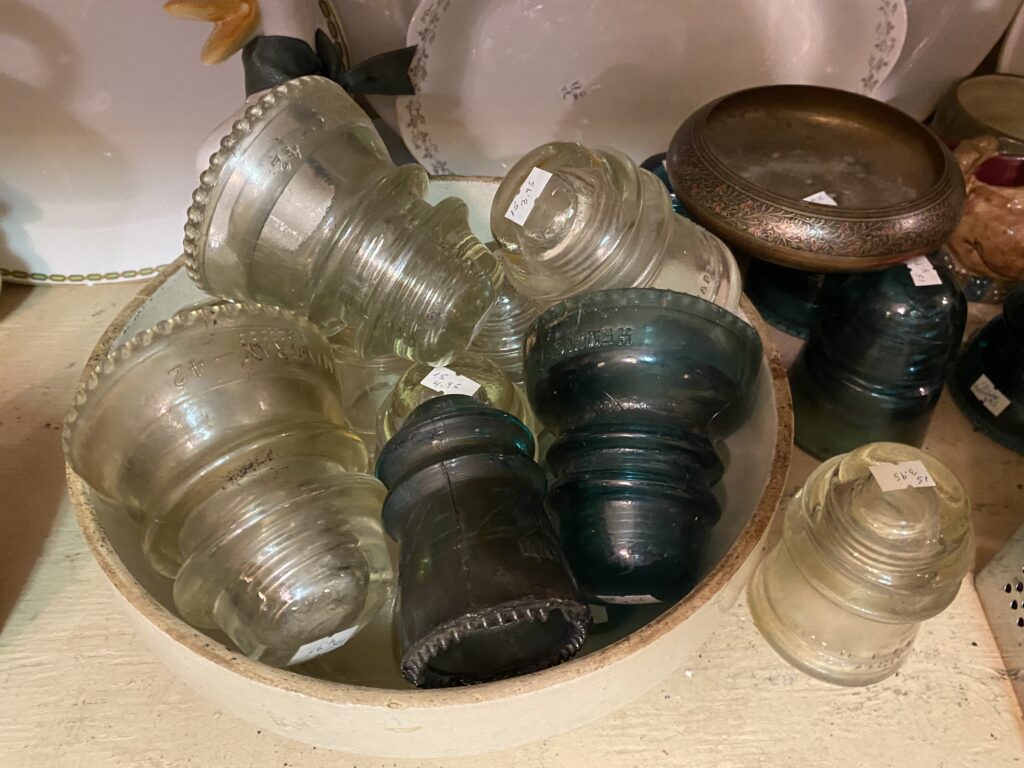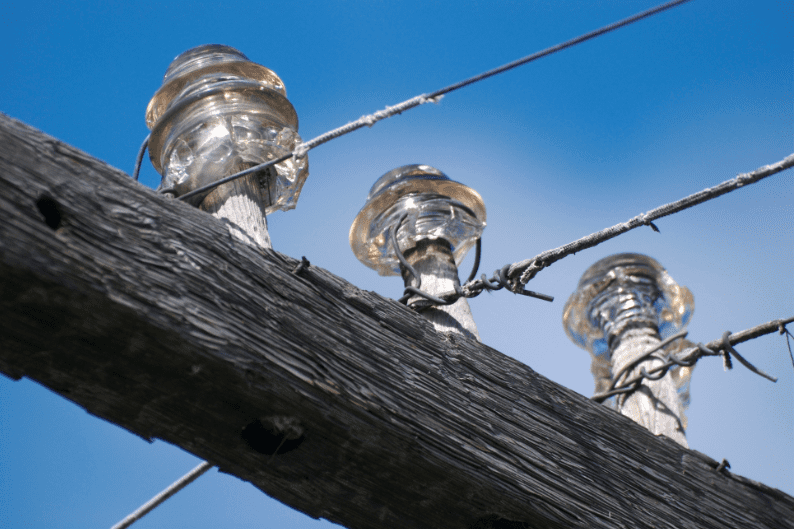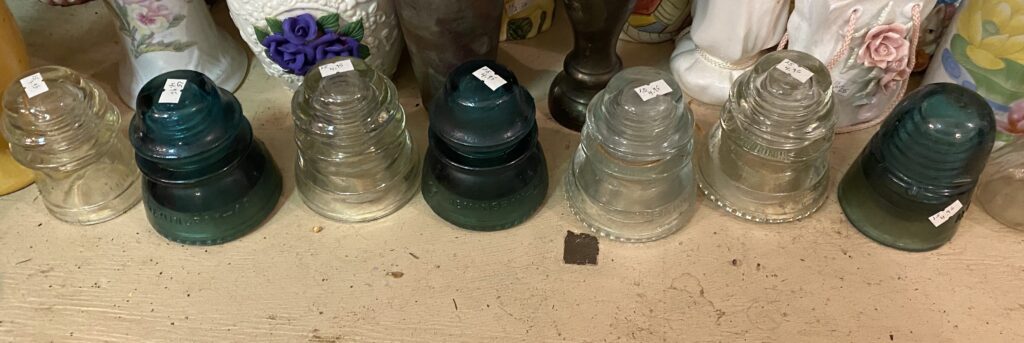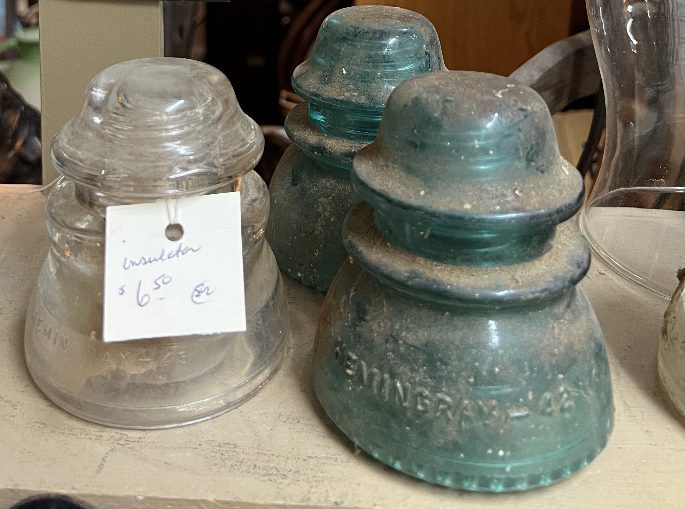
The world of vintage items features many—at first glance odd—pieces from past eras that are fascinating in the way they were once just a part of everyday life. Glass insulators are very much among those items. Found for a few brief decades in most cities and towns, they are now a collector’s piece with a compelling history.
Vintage glass insulators are molded glass objects, designed to secure electrical wires to wooden poles on long-distance runs. The insulators were a safety measure to prevent the wires from losing charge to the wooden poles, a risk that could potentially result in fires along the line. They are rather unique in look: a domed design with a hole through the center and one or more recessed channels around the outer “skirt”, often completed by grooves or teeth along the bottom edge.
Come along as we explore more about why glass insulators were so important to early electrical grids as they helped in the forward motion of technology through the 1800s and 1900s.
Why Did They Use Glass Insulators?
Glass is a natural insulator, electrically speaking. While technically wood is as well, it is not as capable an insulator as glass. Furthermore, what capacity wood does have drops fast in damp or wet circumstances. The technical equations for damp wood and glass’ electrical resistivities—or ability to resist electrical currents—have a factor difference of around 1010 (ten billion)[1], to give an idea of how very different they are.
Here’s why that difference is important: electrical wiring has been run across long distances via wooden posts since the very beginning, during the advent of telegraph wires. However, wiring was not always run inside the plastic, insulated cables we’re used to seeing today.

These wires were exposed, or open. Admittedly, significantly lower voltages were needed for a telegraph system then today’s systems carry, and on average the wires only carried a load of around 50 milliamps[2] at any given time. (By comparison, a modern toaster operates on 7-12 amps or 7000-12000 milliamps.[3])
But humans don’t like standing still for long, and the demand for electricity inevitably grew. Telegraphs had originated in the 1840s; by Jan 1879[4], when Edison invented his lightbulb, the first phone call was already three years past.[5] Reliable and safe electrical feeds were a rising demand and glass insulators were already a major part of the solution.
Something was needed to separate the wire from the wooden poles, to prevent the energy from the wires leaking to the poles. Once the wooden poles’ electrical resistivity was overwhelmed, they were at risk of charring at the least or catching fire at worst. A fire along the line could take down the entire relay, a risk of both safety and reliability. Glass was far better as standing up to the high energy of a live wire without sparking or getting overheated.
What Do Glass Insulators Do?
Glass insulators were used on over-ground wire runs to insulate the charged electrical wires from the supporting wood posts. The insulators had to be molded in such a way as to allow for a) the insulator to be secured to the pole, b) holding charged wires without letting them touch the insulator’s securement or the pole itself, & c) water to run off the insulator as quickly as possible.

These needs usually resulted in a general design (at least in the US) of a dome with two “skirts”—an inner one around a center hole and an outer one. The outer skirt had one or more recessed channels where the wire would be secured with teeth, grooves, or a plain surface at the bottom of the skirt, theorized to encourage swift run-off. The insulator would be secured to the pole with a wooden pin set through the center hole. With this design, the charged wires were successfully secured in the channels, while not touching the pole or the center pin.
The earliest predominate issue with this design was the center securement. Initially it was a smooth peg secured to the insulator with a tar-like substance, either rubbed on or wound in a saturated cloth. Smooth glass doesn’t adhere particularly well in general, and as weather caused varying tension changes in the wires, the insulators would frequently become dislodged from their pins.
In 1865, the most major alteration of insulator design was created by George Chauvet. He cast his insulators with grooves down the interior hole, matched by a threaded pin—a system that proved to hold securely against wire tension.[6] More on the oldest glass insulators here.

Glass insulators were not unique to the US, but collecting them nowadays is not quite as popular outside the US. There are fewer catalogued foreign insulators so far, so the stylings most commonly seen and the bulk of documentation originates from US-made and used glass insulators. [7]
What are Glass Insulators Used For?
Glass insulators were originally used on telegraph wires but transitioned to every other type of long-distance electrical wiring through the late 1800s and early 1900s. In the US, telegraph lines (and eventually telephone lines) were built alongside railways, to keep communication open along the track but also across the country. From there, electrical lines with their resident glass insulators spread into towns that popped up along the railway lines and across the larger cities as well.
For this reason, glass insulators are very commonly found in phenomenally dirty condition initially as the majority have been exposed to decades’ worth of train smoke and soot.[8] (This is one collectable item where cleanliness is typically regarded over an acquired “patina” of time, as that allows the original color and design to be on clear display.)

By now, glass insulators have largely been replaced on the lines, their heyday over by the 1950s. They were first replaced by ceramic and nowadays, rubber silicone insulators[9]. There are, however, a few places glass insulators are still in use around the US, often on remote electrical grids in smaller towns or along railways.
Read more in our article about when and where glass insulators were used.
Collectors treat glass insulators still in service like a birdwatcher tracking a rare bird; they are very well-documented when they’re found. When the insulators were replaced post-1950s, they were typically buried in a hole dug at the base of their respective pole … or in some cases, taken home to children who grew up to become insulator collectors.
Collectors have spent decades by now carefully tracking where to look for these buried spoils so that today, glass insulators initially deemed no longer needed are finding a second life as collectors’ items perched on shelves and in cabinets—a record of early eras of harnessed electricity.
Check out our article on valuing vintage glass insulators for more information.
[1] https://www.thoughtco.com/table-of-electrical-resistivity-conductivity-608499 & https://www.matweb.com/search/QuickText.aspx
[2] https://morsetelegraphclub.org/wirechief
[3] https://www.gotoaster.com/how-many-amps-does-a-toaster-use
[4] https://www.fi.edu/history-resources/edisons-lightbulb .
[5] https://www.americaslibrary.gov/jb/recon/jb_recon_telephone_1.html
[6] https://www.tehachapinews.com/lifestyle/pen-in-hand-antique-insulators-glass-and-porcelain-that-carried-our-conversations/article_31865c2c-3bac-11ea-ac89-3bfc4bd8ca28.html
[7] https://www.nia.org/general/gifona/gifona.htm
[8] https://glassbottlemarks.com/general-overview-glass-insulators/
[9] https://www.elkem.com/silicones/offer/silicone-rubber/energy/insulators/

